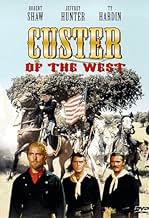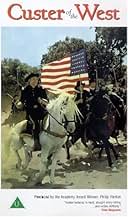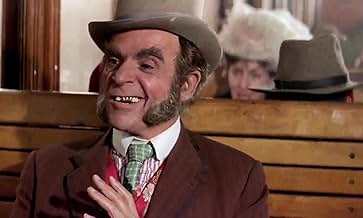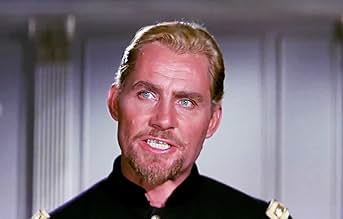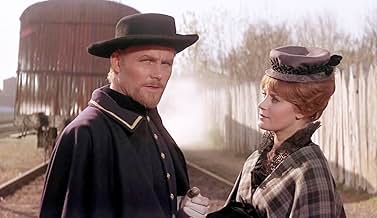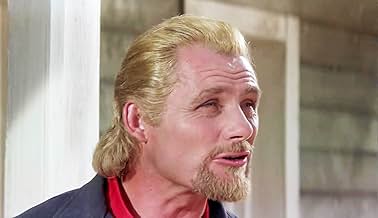Der extravagante Bürgerkriegsheld Custer übernimmt das Kommando über die 7. Kavallerie und will die Reservationspläne der vertragsbrüchigen US-Regierung gegen die aufsässigen Indianer mit Ge... Alles lesenDer extravagante Bürgerkriegsheld Custer übernimmt das Kommando über die 7. Kavallerie und will die Reservationspläne der vertragsbrüchigen US-Regierung gegen die aufsässigen Indianer mit Gewalt durchsetzen. Doch die wehren hartnäckig.Der extravagante Bürgerkriegsheld Custer übernimmt das Kommando über die 7. Kavallerie und will die Reservationspläne der vertragsbrüchigen US-Regierung gegen die aufsässigen Indianer mit Gewalt durchsetzen. Doch die wehren hartnäckig.
Empfohlene Bewertungen
It's impossible to imagine an American Indian watching this without feeling nauseous. Kieron Moore as Dull Knife. And at the end Custer seems to be fighting the Cheyenne -- period -- whereas he fought Sioux almost entirely. There were only seven Cheyenne warriors present at the battle. Westerns seem to enjoy dealing with the Cheyenne whenever they need generic Indians. I think it may be the name of the tribe -- The Cheyenne. It's easy to pronounce, and it sounds good. (It means something like "people with red feet" in Cheyenne.) "Sioux," on the other hand, sounds like a girl's name. "Apache" and "Comanche" are euphonious generic names too, but it's hard to get them all the way up to Montana. So what are you left with -- "Paiute"?
I didn't mind Robert Shaw's accent. He's a decent playwright but, regardless of which accent he's using, he can project nothing more than grim determination. When he seems to be enjoying himself, maybe smiling, you can't help feeling that it's calculated, that he's grimly determined to smile. As written, his role doesn't tell us much about Custer. Sometimes he seems brutal and other times, without too much tiresome exposition, he sounds like a liberal. Mary Ure is really appealing, a decent actress, without being staggeringly beautiful, who died an untimely death. Ty Hardin wasn't much of an actor, and he seemed to go politically bonkers after his brief career as a handsome hunky type. Jeffrey Hunter has a small part as the voice of humanitarianism. Lawrence Tierney has a beaut of a New York accent, but it may not be too out of place. Phil Sheridan was from New Jersey, wasn't he? (I may be wrong, but I don't want to bother looking it up.) Robert Ryan is the best actor in the bunch and his part is completely unnecessary, adding nothing to the picture.
The last stand is epic in a way it probably wasn't in real life, if that matters at all. The dead cavalrymen all wind up in something like a circular pile instead of being scattered along the slope up which they retreated. The Indians leave the remains alone, too, instead of violating them as they actually did. (Custer's body was stripped but unmutilated.) Indians tend not to like this kind of movie. On the anniversary of the battle in 1988 they installed a small plaque of crude, angry cast iron commemorating the many Indians who died in the battle. Right in the shadow of the phallic needle that remembers the 7th Cavalry. As it happens, I was living with the Cheyenne as an anthropologist at the time. I have never met a more admirable people. You don't hear much about Indian resentment of White's assumed superiority because they don't shout loud enough. Jane Fonda on her return from France in 1970 found them boring and too fond of alcohol so she went on to more exciting things.
Besides the imaginary history, the geographical locations presented for the story exist only in the minds of the screen writer and director. Despite this, I could not get over how much I liked watching Shaw present his interpretation of Custer. For all the weaknesses in the script, Shaw was given some great speeches to make, demonstrating the tragedy of plains Indians. No matter how ugly the near genocide of them as a people and the total genocide of their culture, and there is no excuse for any of it, they were the victims of events that were pre-determined once Europeans set foot on North America. A point perfectly captured in the movie in the confrontation between Custer and an American actor posing as a representative Indian chief.
For myself, the worst part of the movie, which I was enjoying up to this point, was the Last Stand. Who cares whether it was accurate or not. When was the last time Hollywood ever made any movie about any historical event or person that was not clearly fiction in many aspects? What bothered me, was the fact it was done on the cheap. Custer had around 260 men with him, in the movie, he might have about 50. There is just no drama in watching a big action sequence that falls flat because you were not willing to hire more extras.
Still, I guess this movie is one of my guilty pleasures. If you like action movies or Robert Shaw, give it a look.
"Custer of the West" both stresses the mistreatment of the plain's Indians by the U.S. and portrays Custer as a tragic American hero who was a puppet of government policy. The film is usually lambasted for its inaccuracies, particularly its depiction of the closing battle. For instance, in real-life Custer's soldiers surprised the Native encampment, they didn't ride up and dialogue with the waiting Indians; moreover, the battle was a chaotic one, moving toward Last Stand Hill. Yet it's not like previous films were any more accurate, e.g. "They Died with Their Boots On" (1941), but audiences apparently demanded more accuracy by the late 60s.
Regardless, the gist of events is true: Reno and Benteen were real-life subordinate officers at odds with Custer and reportedly failed him on the day of battle, although they supposedly had justified cause. If I were Benteen, I would've probably done what he did in the face of Custer's glory-hound rashness and a formidable foe: Dig in, face the enemy, and survive to fight another day. In any case, if you want historical accuracy (to a point) see "Son of the Morning Star" (1991).
The main problem I have with this movie are the Spanish locations substituting for Virginia, the Dakotas and Montana. Fortunately, the creators at least tried to find a setting with trees for Virginia and some of the locations they used for Dakota/Montana occasionally work (just occasionally). But there's a long desert sequence when nothing of the sort exists in the region. You'd have to go far south to New Mexico/Arizona or way further west to eastern Washington to find such deserts. Yet it could be argued that the desert sequence is substituting for the Badlands of the Western Dakotas, which is certainly desert-like.
If you can ignore the disingenuous topographies, there's a lot to appreciate in "Custer of the West." But the film's overlong and bogged down by tedious or useless sequences, like the capture/imprisonment of Sgt. Mulligan (Robert Ryan). But there are some gems, like when Dull Knife (Kieron Moore) pays Custer a visit at the fort (which in real life didn't have a timber stockade). Custer bluntly conveys to the Chief the simple (awful) truth about conquerors and those they conquer: "The problem is precisely the same as when you Cheyenne decided to take another tribe's hunting ground. You didn't ask them about their rights. You didn't care if they had been there a thousand years. You just had more men and more horses. You destroyed them in battle. You took what you wanted and, right or wrong, for better or worse, that is the way things seem to get done. That's history."
FYI: Deviating from the original script, Robert Shaw made the character of Custer over to suit himself, turning him into a "sadist of Shakespearean depth." He also directed the battle scenes with Siodmak staging everything else.
THE MOVIE RUNS 2 hours 21 minutes and was mostly shot 30 miles from Madrid, Spain, except for the Battle of Little Bighorn which was filmed in Costa del Sol near Almira. WRITERS: Bernard Gordon and Julian Zimet with additional work by Shaw.
GRADE: C
Though I live overseas now I grew up in the United States in the 1960s (in fact, I still retain my U.S. citizenship). Some of the lines in this 1967 movie are, in fact, anachronisms (they were not in the language in the 1860s or 1870s when this movie was set). The phrase that one U.S. soldier was worth (in combat) 10 Indians was a takeoff on the phrase used at that time in the Vietnam War concerning the kill ratio. Also, the term that General Sheridan used, "Bleeding hearts" comes from the 1960s; not the 1860s. The director of this movie was obviously comparing the moral problems we felt with Vietnam with the same problems the U.S. felt during the Indian Wars a century before. I did not know, of course, any Indian War veterans, but I did know two good men who went to Vietnam and did not come back alive.
Also tearful is the real life love you detect between George and Libby Custer that is portrayed by the real life married couple of Robert Shaw and Mary Ure. Six children between them. She died about ten years later from an accidental overdose of alcohol mixed with sleeping pills. He was so heartbroken that he died a few years later literally of a broken heart.
It is still a magnificent film. The western scenes are indigenous to that part of the United States that it is actually a shock to find out they were filmed not in South Dakota, California, Nevada, Kansas,etc. but rather in Spain!!
Wusstest du schon
- WissenswertesSome sources have suggested that this was originally to be directed by Akira Kurosawa, but he pulled out. However, this is massively unlikely, given the production history of the film. The more likely explanation is that Kurosawa was approached about directing a different film project on the same subject, "The Day Custer Fell", which was in the works at 20th Century Fox for several years, and for which several Japanese actors famous for working with Kurosawa were approached to play the leading Native American roles. Fred Zinnemann was eventually attached to this project, but it was canceled by Fox because of its ever-escalating budget. "Custer Of The West" was put together very quickly (and made rather cheaply) once this occurred.
- PatzerThe troops of the 7th Cavalry are shown with 1873 Winchester rifles, which were in wide use by 1876, but not by the US Army. Custer's men were armed, as all troopers who did not purchase their own rifles were, with the 1873 Springfield Trapdoor carbine, a single-shot weapon. Had Custer's men been armed with the Winchester, it is possible, though unlikely, that they could have held out until relieved.
- Zitate
Gen. Philip Sheridan: You know, you could become a living legend... or get yourself killed. Dead men make better legends.
- Alternative Versionen35mm prints released in both complete and shortened versions. Some shortened versions were titled "A Good Day for Fighting".
- VerbindungenFeatured in I Am Not Your Negro (2016)
Top-Auswahl
- How long is Custer of the West?Powered by Alexa
Details
- Erscheinungsdatum
- Herkunftsländer
- Sprache
- Auch bekannt als
- Last Post - US Kavallerie Western-Klassiker Box
- Drehorte
- Produktionsfirmen
- Weitere beteiligte Unternehmen bei IMDbPro anzeigen
Box Office
- Budget
- 4.000.000 $ (geschätzt)
- Laufzeit2 Stunden 20 Minuten
Zu dieser Seite beitragen


